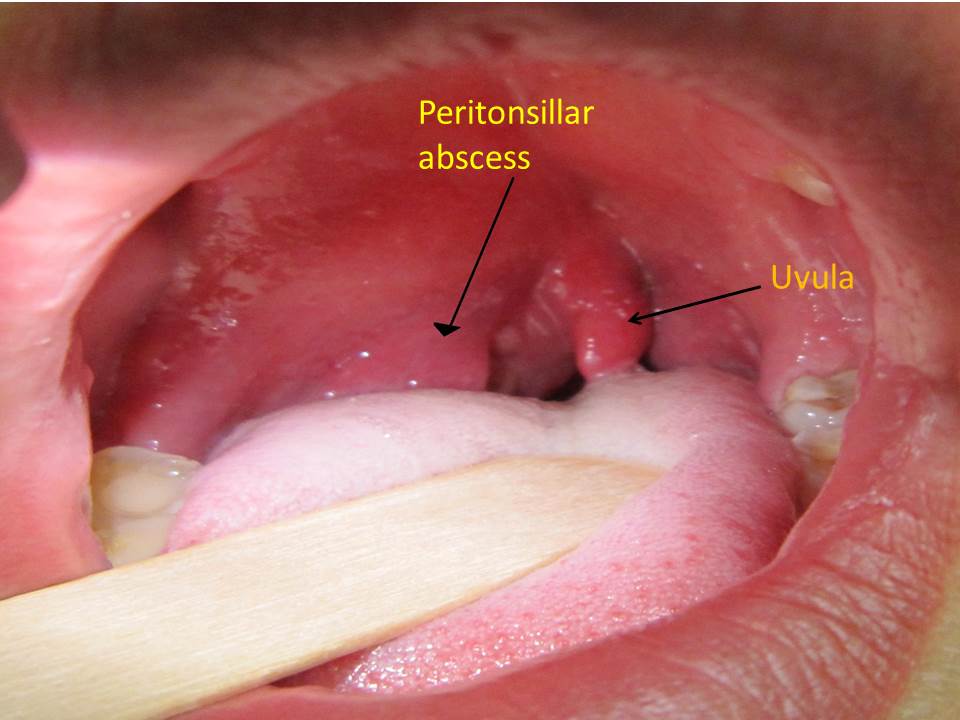Peritonsillar abscess physical examination
|
Peritonsillar abscess Microchapters |
|
Diagnosis |
|
Treatment |
|
Case Studies |
|
Peritonsillar abscess physical examination On the Web |
|
American Roentgen Ray Society Images of Peritonsillar abscess physical examination |
|
Risk calculators and risk factors for Peritonsillar abscess physical examination |
Editor-In-Chief: C. Michael Gibson, M.S., M.D. [1] Associate Editor(s)-in-Chief: Prince Tano Djan, BSc, MBChB [2]
Overview
On physical examination, patients are usually acutely ill-looking and may have high temperature, muffled voice (also called "hot potato voice"), contralateral deflection of the uvula, the tonsil is generally displaced inferiorly and medially, facial swelling, tonsillar hypertrophy, trismus, drooling, tenderness of anterior neck and tender submandibular and anterior cervical lymph nodes[1][2][3][4]
Physical examination
Physical examination findings suggestive of peritonsillar abscess include the following:[1][5][3][4]
Appearance of the Patient
- They are usually acutely ill-looking.
Vital Signs
- High temperature
HEENT
- Muffled voice (also called "hot potato voice")
- Contralateral deflection of the uvula (see image below)
- The tonsil is generally displaced inferiorly and medially
- Facial swelling
- Tonsillar hypertrophy with likely peritonsillar edema (see image below)
- Trismus
- Drooling
- Rancid or fetor breath
The image below shows edematous and inflamed tonsil on the right with contralateral uvula deviation:[6]

Neck
- Tenderness of anterior neck
- Tender submandibular and anterior cervical lymph nodes
Lungs
- May be in obvious respiratory distress with flaring of ala nasi, subcostal and intercostal recessions.
- Increased respiratory rate in both children and adults
- Decreased air-entry depending on degree of airway obstruction
Extremities
References
- ↑ 1.0 1.1 Galioto NJ (2008). "Peritonsillar abscess". Am Fam Physician. 77 (2): 199–202. PMID 18246890.
- ↑ Ferri, Fred (2015). Ferri's clinical advisor 2015 : 5 books in 1. Philadelphia, PA: Elsevier/Mosby. ISBN 978-0323083751.
- ↑ 3.0 3.1 Passy V (1994). "Pathogenesis of peritonsillar abscess". Laryngoscope. 104 (2): 185–90. doi:10.1288/00005537-199402000-00011. PMID 8302122.
- ↑ 4.0 4.1 Nwe TT, Singh B (2000). "Management of pain in peritonsillar abscess". J Laryngol Otol. 114 (10): 765–7. PMID 11127146.
- ↑ Ferri, Fred (2015). Ferri's clinical advisor 2015 : 5 books in 1. Philadelphia, PA: Elsevier/Mosby. ISBN 978-0323083751.
- ↑ DescriptionEnglish: A right sided peritonsilar abscess Date 13 May 2011 Source Own work Author James Heilman,MD wikimedia commons https://commons.wikimedia.org/wiki/File:PeritonsilarAbsess.jpg